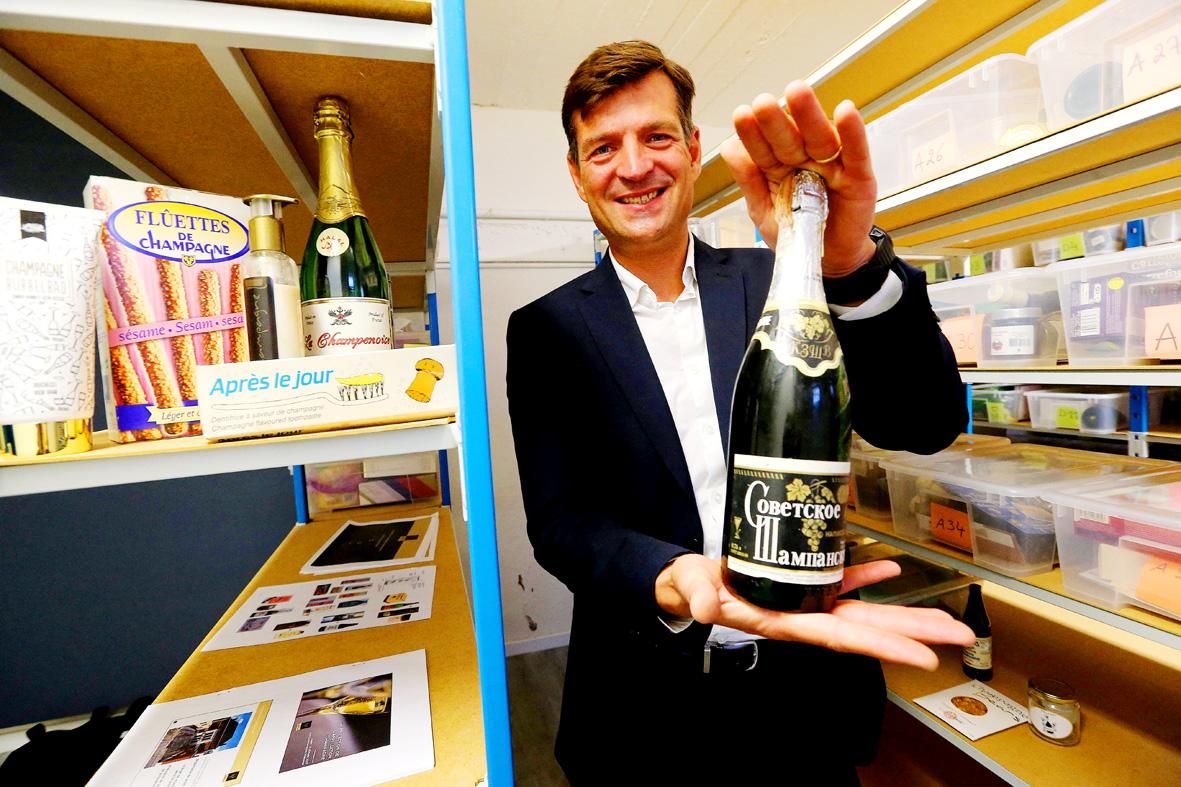Makers of perfumes, sodas or even condoms who hope to add fizz to their products by labeling them “Champagne” quickly find out that it’s risky to take the name of the world’s most famous bubbly in vain.
The powerful Interprofessional Committee of Champagne Wine (CIVC) association, which groups the famed eastern French region’s 16,200 growers and 360 brands, tracks anyone in the world who hijacks the Champagne name.
According to laws in France, the EU and elsewhere, the label can only be used for sparkling wine produced in their precisely defined part of the country.

Photo: AFP
“It’s the price of glory,” said Roxane de Varine-Bohan, one of five lawyers at CIVC looking after brand protection.
The body has hunted down countless samples of products using the Champagne name over the decades.
Helped by the French government, and increasingly by foreign authorities, the association handles about 1,000 cases in 80 countries every year.
One high-profile dispute erupted in June when Russia turned the tables on France by passing a law that says only Russian bubbly can be called “Champagne,” while French Champagne has to be labeled “sparkling wine.”
Three French cabinet ministers have since written to their Russian counterparts demanding a suspension of the new law, said CIVC boss Charles Goemaere, adding he hoped for a response sometime this month.
Also in June, customs services in the northern French port of Le Havre seized 750 bottles of a cola drink labeled “Couronne Fruit Champagne” that had been ordered from Haiti by a Parisian restaurant.
The CIVC is planning to bring a civil suit against the drink’s distributor while trying to locate its producer.
“Our aim is not to win damages, but to ban the use of the Champagne name for this product that is sold in the French Caribbean and in South America,” Varine-Bohan said.
‘WE’LL GET THERE’
Around 120 nations officially recognize the Champagne name as copyrighted including China “which protects it very well,” said Goemaere.
Others still won’t play ball, he said, including the US, Russia, Belarus and Haiti.
“But we’ll get there,” he added.
The recognition of Champagne as a protected designation of origin dates back to 1936.
But even as long ago as 1843, a group of Champagne growers won a court order preventing Touraine growers in central France from using the label.
Most of the hunt for offenders goes on discreetly, but occasionally there are high-profile cases such as when the Yves Saint Laurent fashion group had to change the name of its “Champagne” perfume.
“We accomplish painstaking work against the hijacking of our name. Nothing can stop us,” Varine-Bohan said.
Not even a village in Switzerland called Champagne that claimed it should be allowed to market its wines using its own name — the CIVC filed a lawsuit and obtained, thanks to Swiss-EU accords, a ban on the Swiss Champagne challenge.
British sweets and a German cola drink, both called champagne, also never stood a chance against the CICV’s wrath.
The association relies on a network established by Champagne houses in 10 countries as well as 70 law firms across the world for its intelligence.
But the bulk of tip-offs comes from champagne drinkers who won’t stand for their favorite tipple’s name being misappropriated.
They account for some 80 percent of cases, said Goemaere.
As long as champagne enjoys worldwide fame, “there’s money to be made” from stealing its name, he sighed.
“Our work is never done.”

One of the biggest sore spots in Taiwan’s historical friendship with the US came in 1979 when US president Jimmy Carter broke off formal diplomatic relations with Taiwan’s Republic of China (ROC) government so that the US could establish relations with the People’s Republic of China (PRC). Taiwan’s derecognition came purely at China’s insistence, and the US took the deal. Retired American diplomat John Tkacik, who for almost decade surrounding that schism, from 1974 to 1982, worked in embassies in Taipei and Beijing and at the Taiwan Desk in Washington DC, recently argued in the Taipei Times that “President Carter’s derecognition

This year will go down in the history books. Taiwan faces enormous turmoil and uncertainty in the coming months. Which political parties are in a good position to handle big changes? All of the main parties are beset with challenges. Taking stock, this column examined the Taiwan People’s Party (TPP) (“Huang Kuo-chang’s choking the life out of the TPP,” May 28, page 12), the Democratic Progressive Party (DPP) (“Challenges amid choppy waters for the DPP,” June 14, page 12) and the Chinese Nationalist Party (KMT) (“KMT struggles to seize opportunities as ‘interesting times’ loom,” June 20, page 11). Times like these can

Dr. Y. Tony Yang, Associate Dean of Health Policy and Population Science at George Washington University, argued last week in a piece for the Taipei Times about former president Ma Ying-jeou (馬英九) leading a student delegation to the People’s Republic of China (PRC) that, “The real question is not whether Ma’s visit helps or hurts Taiwan — it is why Taiwan lacks a sophisticated, multi-track approach to one of the most complex geopolitical relationships in the world” (“Ma’s Visit, DPP’s Blind Spot,” June 18, page 8). Yang contends that the Democratic Progressive Party (DPP) has a blind spot: “By treating any

You can tell a lot about a generation from the contents of their cool box: nowadays the barbecue ice bucket is likely to be filled with hard seltzers, non-alcoholic beers and fluorescent BuzzBallz — a particular favorite among Gen Z. Two decades ago, it was WKD, Bacardi Breezers and the odd Smirnoff Ice bobbing in a puddle of melted ice. And while nostalgia may have brought back some alcopops, the new wave of ready-to-drink (RTD) options look and taste noticeably different. It is not just the drinks that have changed, but drinking habits too, driven in part by more health-conscious consumers and